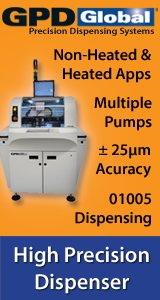Casimir: Resistivity of Solvent Extract (ROSE) testers measure ionic contamination by washing boards with a DI water/IPA solution. (No-clean people: Stop and go on to something else.) The testers are process control instruments used to monitor a relative contamination (cleanliness) level, established as a comparison with a quality baseline. ROSE testers can be dynamic or static. EMPF studied Rose testing and testers ("An In-Depth Look At Ionic Cleanliness Testing," RR0013, August 1993) and found the dynamic to be more accurate.
Most testers measure resistivity, rather than conductivity. The concentration of ionized material varies linearly with the conductivity of a solution, where the resistivity of the solution is non-linear.
DYNAMIC TESTERS: Ionograph and Zero-Ion measure the resistivity of the solution leaving the test tank, deionize it, return it to the tank, and continue, until the solution resistivity returns to the initial baseline. The tester calculates dissolved contamination from the time versus resistivity sample curve. This approach depends on:
� Working the solution for long times at high conductivities where the CO2 absorption from the air highest and least predictable. � Ability of DI columns to remove all the ions in a single pass. � Instantaneous differentiation of ionic materials.
... possibly over-estimating the contamination level. Additionally, if set-up with a very high resistivity baseline, the test time can be very long and may end-up detecting ions from substrate materials and components, which have little to do with controlling assembly processes.
STATIC TESTERS: The Omega Meter, Contaminometer, among others measure the resistivity (or possibly conductivity) of the solution leaving the test tank, return it to the tank, and continue, until the resistivity (or conductivity) of the solution declines to a baseline. The tester calculates the accumulated ions in the solution. These testers are:
� Less sensitive to CO2 absorption than dynamic testers. � Generally, more accurate, except that - if the volume of solution was too small - there is a risk of saturation, resulting in a low reading. � Able to have lower test times. Some testers of this type: - Stop the test automatically when conductivity stops rising, reducing test time, rather than testing for a fixed time period. - Extrapolate (automatically by software ) with a reasonable accuracy to the end point, if a test has ended, but the conductivity is still rising.
Operators like Omega Meters
Our old, sadly departed (from SMTnet) friend Brian Ellis makes a static tester and talks about the differences between tester types on: http://www.protonique.com/psagraph/files/statdy.htm.
Various peoples' 2�
Dave F
reply »
![]() Does anyone know anything about Aqueos Technologies Zero-Io...
- Feb 01, 2000
by
Casimir Budzinski
Does anyone know anything about Aqueos Technologies Zero-Io...
- Feb 01, 2000
by
Casimir Budzinski
![]()
![]()
![]() Casimir: Resistivity of Solvent Extract (ROSE) testers mea...
- Feb 02, 2000
by
davef
Casimir: Resistivity of Solvent Extract (ROSE) testers mea...
- Feb 02, 2000
by
davef
![]()
![]()
![]() As the manufacturer of the Zero-Ion, I must correct one sta...
- Feb 02, 2000
by
As the manufacturer of the Zero-Ion, I must correct one sta...
- Feb 02, 2000
by
![]()
![]() Mike: I'm just glad I got away with the rest of the stuff ...
- Feb 03, 2000
by
davef
Mike: I'm just glad I got away with the rest of the stuff ...
- Feb 03, 2000
by
davef
![]()







